
The 52nd Lowland Volunteers is a battalion in the British Army's Army Reserve or reserve force in the Scottish Lowlands, forming the 6th Battalion of the Royal Regiment of Scotland, also known as 6 SCOTS. Due to its erstwhile association with the 1st Regiment of Foot, it is the senior Reserve line infantry battalion in the British Army. It is one of two Reserve battalions in the Royal Regiment of Scotland, along with 51st Highland, a similar unit located in the Scottish Highlands.
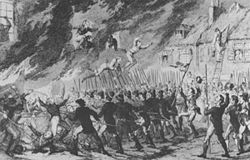
The Battle of Prosperous was a military engagement between British Crown forces and United Irishmen rebels during the Irish Rebellion of 1798 in the town of Prosperous, County Kildare. Prosperous was founded by Sir Robert Brooke in 1780 as a village for processing cotton produced in the Americas. When a rebellion spearheaded by the United Irishmen broke out against British rule in Ireland, rebel forces led by John Esmonde made plans to capture Prosperous. Esmonde had 200 rebels under his command, while Prosperous was garrisoned by elements of the Royal Cork City Militia under the command of Captain Richard Swayne reinforced by detachments of a Welsh mounted fencible regiment, the Ancient British Regiment of Fencible Cavalry Dragoons, numbering 150 men in all.
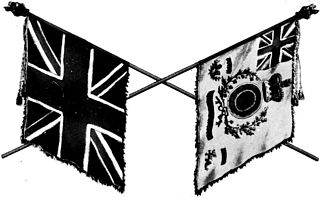
The 26th (Cameronian) Regiment of Foot was an infantry regiment of the Scots Army and subsequently a Scottish infantry regiment of the British Army, active from 1689 to 1881. Although the regiment took the name of its first colonel as The Earl of Angus's Regiment, it became popularly known as The Cameronians until 1751, when it was ranked as the 26th Foot. Under the Childers Reforms it amalgamated with the 90th Regiment of Foot to form the Cameronians in 1881. The Cameronians were themselves disbanded in 1968, meaning that no Army unit today perpetuates the lineage of the 26th Foot.
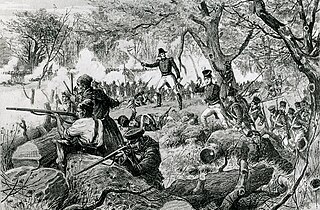
When the United States and the United Kingdom went to war against each other in 1812, the major land theatres of war were Upper Canada, Michigan Territory, Lower Canada and the Maritime Provinces of Nova Scotia, New Brunswick, Prince Edward Island and Cape Breton . Each of the separate British administrations formed regular and fencible units, and both full-time and part-time militia units, many of which played a major part in the fighting over the two and a half years of the war.

The Glasgow Highlanders was a former infantry regiment of the British Army, part of the Territorial Force, later renamed the Territorial Army. The regiment eventually became a Volunteer Battalion of the Highland Light Infantry in 1881. The regiment saw active service in both World War I and World War II. In 1959 the Highland Light Infantry was amalgamated with the Royal Scots Fusiliers to form the Royal Highland Fusiliers. The Glasgow Highlanders was later amalgamated into the 52nd Lowland Volunteers in 1967.
The 80th Regiment of Foot (Staffordshire Volunteers) was an infantry regiment of the British Army, raised in 1793. Under the Childers Reforms it amalgamated with the 38th (1st Staffordshire) Regiment of Foot to form the South Staffordshire Regiment in 1881.

British Military Hospitals were established and operated by the British Army, both at home and overseas during the 19th and 20th centuries, to treat service personnel. They varied in size, purpose and permanence.
The Cambridgeshire Militia was an auxiliary military regiment in the English county of Cambridgeshire and the Isle of Ely. From their formal organisation as Trained Bands and their service during the Armada Crisis and in the English Civil Wars, the Militia of Cambridgeshire served during times of international tension and all of Britain's major wars. The regiment provided internal security and home defence but sometimes operated further afield, relieving regular troops from routine garrison duties and acting as a source of trained officers and men for the British Army. It later became a battalion of the Suffolk Regiment until its final disbandment in 1908.
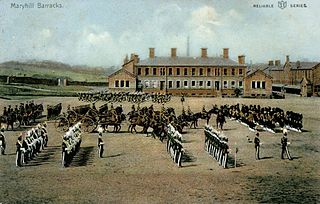
Maryhill Barracks was built on 12 hectares of the Ruchill estate, in the Maryhill area of northern Glasgow, Scotland.
The plan of raising a fencible corps in the Highlands was first proposed and carried into effect by William Pitt the Elder, in the year 1759. During the three preceding years, both the fleets and armies of Great Britain had suffered reverses, and it was thought that a "home guard" was necessary as a bulwark against invasion.
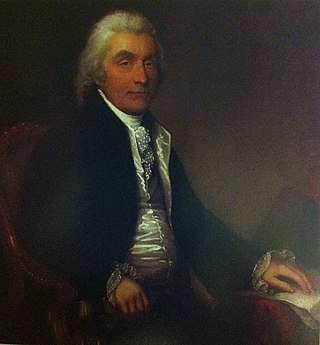
The Royal Nova Scotia Regiment was a battalion of infantry raised in 1793 to defend British interests in the colony of Nova Scotia during the Wars of the French Revolution. The unit was commanded by Colonel John Wentworth, the lieutenant-governor of the colony, throughout its existence. The Royal Nova Scotia Regiment (RNSR) had an undistinguished history through most of its existence, and saw very limited action, mostly in the role of marines, but did play an important role in the defense of Nova Scotia during these wars.
The Militia and Volunteers of County Durham are those military units raised in the County independent of the regular Army. The "modern" militia dates from legislation enacted during the Seven Years' War. The volunteers had several forms and separate periods of existence until made a permanent body in 1859.

Hamilton Barracks was a military installation in Hamilton, South Lanarkshire.
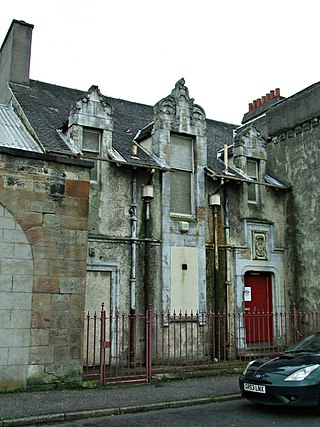
Paisley Barracks was a military installation in Paisley, Renfrewshire.
The Argyll & Bute Militia was a part-time military unit in the west of Scotland from 1798 to 1909, serving in Home Defence during the French Revolutionary War, Napoleonic Wars and Second Boer War. Originally an infantry regiment, it was converted into artillery in 1861.
The Windsor Foresters, or more formally the Berkshire Fencible Cavalry, was a British regiment of cavalry raised for home defence in 1794. It served in Lincolnshire and Scotland on coastal defence and anti-smuggling duties until 1800. A second regiment, the Berkshire Provisional Cavalry was converted into fencible cavalry in 1799. Both regiments were disbanded in 1800, when a number of members transferred to a new Yeomanry Cavalry Troop at Wargrave.
The Queen's Edinburgh Light Infantry Militia was an auxiliary regiment raised in and around the city of Edinburgh in Scotland. It was formed in 1798 and reformed in 1802, but had links with earlier Fencible and Volunteer units from the area. It served in home defence during the Napoleonic Wars and the Crimean War. Later it became a battalion of the Royal Scots and saw active service in South Africa during the Second Boer War. It served as a Special Reserve training unit in World War I, but after 1921 the militia had only a shadowy existence until its final abolition in 1953.
The Montgomeryshire Militia, later the Royal Montgomeryshire Rifles, was an auxiliary regiment reorganised in the Welsh county of Montgomeryshire during the 18th Century from earlier precursor units. Primarily intended for home defence, it served in Great Britain and Ireland during Britain's major wars. It later became part of the South Wales Borderers until it was disbanded in 1908.
The Royal Tyrone Militia, later the Royal Tyrone Fusiliers, was an Irish militia regiment raised in 1793 for home defence and internal security during the French Revolutionary War, seeing action during the Irish Rebellion of 1798. It was later embodied during all of the UK's major wars. In 1881 it became a battalion of the Royal Inniskilling Fusiliers and during World War I, as part of the Special Reserve, it trained thousands of reinforcements for battalions of that regiment serving overseas. Postwar it retained a shadowy existence until it was formally disbanded in 1953.











